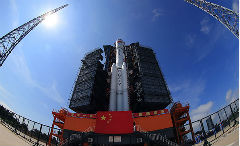Three cargo vehicles to serve nation’s space program
2017-04-29
China Daily
China will produce two additional types of cargo spacecraft with different functions to service its future manned space station, according to a space program manager.
That will make a total of three, including Tianzhou 1, which is now in space, Yang Baohua, deputy general manager of China Aerospace Science and Technology Corp, said at a news conference on April 28 in Beijing.
That spaceship’s cargo cabin is hermetically sealed because one of the spacecraft’s tasks is to test in-orbit resupply technology, including the transportation of astronauts’ necessities that require isolation from space.
“We will design two variants of Tianzhou 1,” Yang said. The first variant will have a cargo area that is hermetically sealed like the Tianzhou 1 as well as a cargo area that is partly open to space to allow for more storage, he said.
The first variant will be used to transport astronauts’ supplies and small spare parts needed at the space station.
The second variant will be open and will carry cargo that does not need protection from space conditions. It will haul large parts as well as any spacecraft to be launched from the station, he said.
In the case of all three types of spacecraft, the propulsion cabin will remain hermetically sealed like that of Tianzhou 1, Yang said. None of the craft will be designed to be reusable.
Tianzhou 1, China’s first cargo spacecraft, has completed the country’s first in-orbit refueling test with the Tiangong II space laboratory, the China Manned Space Agency said on April 27. The success of the five-day test made China the third nation in the world to have in-orbit refueling technology after Russia and the United States, it noted.
Tianzhou 1, the country’s largest and heaviest spacecraft, was launched at the Wenchang Space Launch Center in Hainan province on April 20. Tiangong II has been in space since mid-September and carried two Chinese astronauts from mid-October to mid-November. It is now unmanned.
The agency said that after the first test, the two spacecraft would stay connected as they orbit Earth for about two months. After the two months, the cargo spacecraft will undock and dock again with the space lab. It will then undock again and start a three-month independent flight before a third docking.
The cargo craft will inject fuel into Tiangong II during the second and third dockings. After the third docking, Tianzhou 1 will depart from Tiangong II and will be directed by ground control to fall back to Earth.
In the future, the Tianzhou-series cargo spacecraft will be tasked with bringing supplies of fuel, spare parts and other necessities to China’s planned manned space station, which will start construction around 2019 and is expected to enter service by about 2022.
The space station will consist of three parts-a core module attached to two space labs, each weighing about 20 tons-and will operate for at least 10 years, according to the manned space agency.
Zhao Guangheng, chief designer of scientific applications at the manned space agency, said on April 27 that the space station will conduct 30 research and experimental projects in eight major fields including life science, biology, and material science.


